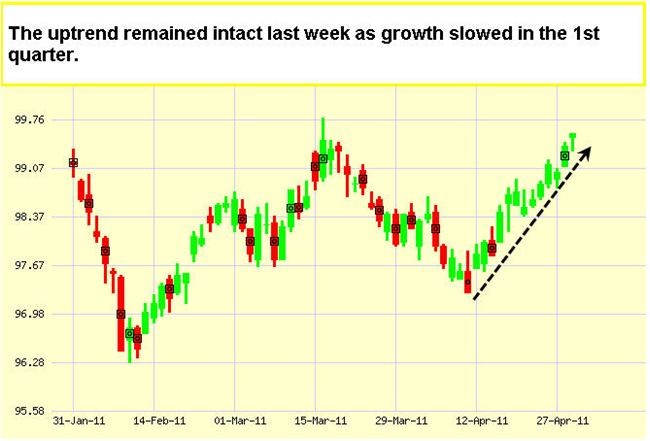| ||||||||||||||
| For the week of May 02, 2011 --- Vol. 9, Issue 18 |
| In This Issue... |
|
|
| Last Week in Review: Fed Chairmen Ben Bernanke spoke...and I was listening. Learn what he said, and what this could mean for home loan rates. Forecast for the Week: The job market labors on, but will Friday’s Jobs Report for April be painful? View: Ever wondered how healthy your neighborhood is? There’s an easy way to find out! |
| Last Week in Review |
|
|
| "SLOW AND LOW, THAT IS THE TEMPO..." Just like these lyrics from the "Beasties Boys" song, slow and low have been the tune for the Bond market recently, as we’ve seen our slow economy cause home loan rates to move lower recently. What’s been happening, and where are the economy and rates headed? Read on to learn more.
So what does all of this mean for home loan rates in the short and long term? An important factor to keep in mind is the US Dollar, which continues to decline. With QE2 and the dollar printing presses going full steam through the end of June - we should expect the "greenback" to erode further, and how the US Dollar performs after QE2 may have a meaningful effect on the Bond market and home loan rates. A persistent weak US Dollar is ultimately not good for Bonds or home loan rates, as a continued decline would make US dollar denominated assets like Treasuries and Mortgage Bonds (to which home loan rates are tied) less attractive. A weak Dollar is also inflationary, as it makes our exports more expensive. The bottom line is this: In the short term, Bond prices are close to a position to break out higher, which would lower home loan rates further still. However, in order for this to happen, the Bond must break above a tough level of technical resistance. Longer-term, how the economy performs post-QE2 will determine which way Bonds and rates are headed at that point, but it’s most likely they’ll trend higher. If the economy, which still has stubbornly high unemployment and millions out of work, doesn't pick up on its own post-QE2, then the Fed will continue its accommodative monetary policy as much as it can to avoid inflation. This is to support the economy and push Stocks higher still...but this would have a further negative effect on the US Dollar, as well as Bonds and home loan rates. If you have been thinking about purchasing or refinancing a home, call or email me to learn more about why now is a great time to benefit from today’s historically low rates. Or forward this newsletter on to someone you know who may benefit. |
| Forecast for the Week |
|
|
Remember: Weak economic news normally causes money to flow out of Stocks and into Bonds, helping Bonds and home loan rates improve, while strong economic news normally has the opposite result. As you can see in the chart below, Bonds and home loan rates have improved due to the slowing in the economy. I’ll be watching closely to see if this trend continues.
Chart: Fannie Mae 4.0% Mortgage Bond (Friday Apr 29, 2011)
|
| The Mortgage Market Guide View... |
|
|
| Know Thyself. And Thy Community! Whether you’re looking to make local business decisions, integrate into a new neighborhood, or find volunteering opportunities where there is a need, it’s important to be informed about the health of your community. Fortunately, finding that information is quick and convenient when you visit http://www.countyhealthrankings.org. This website brings together 50 reports through the collaboration of the Robert Wood Johnson Foundation and the University of Wisconsin Population Health Institute. The result is a health ranking of each state’s counties. How Does Your Community Rank? 1. Simply visit http://www.countyhealthrankings.org. It’s that easy. With just a few clicks, you can see your county’s overall ranking as well as important local statistics related to:
Check out your county today - and share this information with friends, family members, and co-workers in your community!
Economic Calendar for the Week of May 2-6, 2011 Remember, as a general rule, weaker than expected economic data is good for rates, while positive data causes rates to rise. Economic Calendar for the Week of May 02 - May 06
|





No comments:
Post a Comment